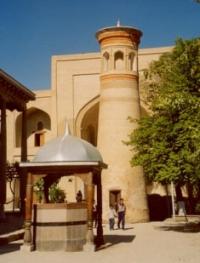You are here
History mausoleum Baghautddin Nakshbandi.


Tours on historical a monument of Bukhara of province.
«Memory is the treasure house of the mind wherein the monuments thereof are kept and preserved»
Thomas Fuller.
Coach trip from Bukhara to Gizhduvan.
The holiest of all monuments of the Old Town of Bukhara is not situated, as you might expect, in the heart of this 2500 year old town but rather a few few km's outside, in the village by the name of Bakhauddin.
The mausoleum of Bakhauddin Nakshband and the entire ensemble around it is one of the most revered places in the Islamic world, scattered with shrines, shrouded by legends, visited by pilgrims from all over Uzbekistan and the entire globe.
Bakhauddin (The Ornamentation of Religion) was born in 1318 in the village of Kasri Orifon, not far from the present complex, into a family of metalworkers, which gave him his surname Nakshbandi (Engraver of Metals).
His birth was prophesied and his life a predilection from above. At an early age the gifted child Bakhauddin Nakshbandi was sent to study under Sheikh Abdalkhalik Gijduvani, founder of the “Khodjagon”, an order of dervishes-mystics, whose teachings later became the base for the “Nakshbandi” order.
A full 12 years the young Bakhauddin spent under the tutelage of Khalil Sultan, the nephew of Tamerlane himself. According to the Encyclopedia of Islam, he devoted himself to “the care of animals for seven years and road-mending for another seven”.
Bakhauddin Nakshbandi traveled extensively, alone 3 times he made the pilgrimage to Mekka. He was an ardent reader, studied the Koran and philosophical works of his era and that of his forefathers and ultimately fullfilled his life's achievement by founding the “Nakshbandi” order.
His philosophy of life was based on 4 principles: work hard without falling prey to fanatic asceticism, enjoy life in moderation, without abusing, interest yourself in the ways of the world and move with your time and 4th, strive for constant self-perfection.
Nakshbandi held strong the believe that dervishes-Sufi should be neatly dressed, not roam as beggar but earn a living. His favorite saying was, “Dil ba yoru, dast ba kor”, which means “devote your heart to the beloved (Allah) and your arms to work”.
All his life was permeated with the holy Sufic number 7; in the 7th month the saint came into the world, in his 7th year he knew the Koran by heart and at the age of 70 he breathed his last breath.
Bakhauddin Nakshbandi passed away in March 1389 and over his grave a simple tomb was set. Nakshbandi's students and followers, who settled nearby, protected and took care of it and ordinary people as well as nobles started arriving on their pilgrimage just as today pilgrims from all over Uzbekistan and indeed the entire world visit this site.
In 1545 Abdulaziz I built an imposing “khanaka” (hostels for dervishes) next to the shrine. In the XVII century by the order of the ruler of Khorezm, Abdulaziz Khan II, the original tomb was replaced by an impressive burial vault with a stone wall around it into which a black rock, the Stone of Desire was incrusted.
Near the burial vault he ordered to build a spiritual complex, consisting of two mosques connected by an arcade. In 1727 a large mosque with two Aywans was commissioned by the order of Abul Fayz Khan's mother.
This complex also includes the dwelling, where Nakshbandi was born and raised. At the end of the XX century, the house was pulled down and the bricks were used to build a small but elegant minaret.
In 1993, on the 675th anniversary of Nakshbandi's birth, the complex was restored. The main entrance portal to the vast expanse of the site is decorated with majolica in the national style. The complex is centered around a pool and the so-called “Wishing Tree”, the dead trunk of a very old mulberry tree linked by legends to Bakhauddin himself.
Good luck (in particular for barren women) is said to be bestowed on those who crawl under it three times. Behind the pool lies a mosque with an elegant minaret and spiral staircase. Next to the mosque 2 gates lead to the cemetery, the necropolis of Bukhara's Khans and noble men.
On the left of the main gate, one first passes the mosque with the 2 Aywans from where a passage leads to the inner yard, the place of Bakhauddin Nakshbandi's tomb. It is a most peaceful moment to watch the pilgrims from near and far circumnabulating the roped in site 3 times in the hope that their wishes may be granted and they may be blessed.
Centuries have passed since Bakhauddin Nakshbandi taught his students and followers; the order of “Nakhshbandi” doesn't count as many members as it used to, but there are those who live as far as America, Australia and all over Europe who still follow the rules set by one of the holiest saints in Islam more than 600 years ago, Bakhauddin Nakhshbandi.
On the grounds one can also visit the graves of Bakhauddin Nakshbandi's mother Bibi Orif and two of his aunts (his father's and mother's sisters), a small mosque and a holy well. At different times different rulers were keen to make their own additions to the ensemble.
Luckily, all attempts at erecting a covered mausoleum over Baukhauddin's grave site somehow failed, somebody or something consistently interefered with the success of such an undertaking.
Legends have it that Saint Bakhauddin did not allow for his grave to be covered, as he had always led a simple life, sleeping in the open air under the stars and that is how he wished to rest forever.
Authority:
Niyara Ibragimova. http://www.discovery-central-asia.com







